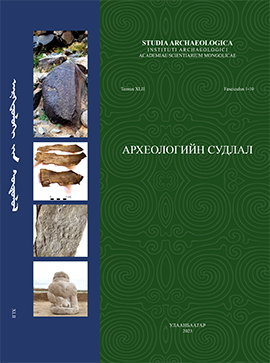An analysis of some artifacts discovered in 2019 from the Khutlug khagan’s memorial complex
DOI:
https://doi.org/10.5564/sa.v42i1.2819Keywords:
Nomgon Valley, Turkic aristocratic memorial complex, Tang culture, Stone lion, roof ending tile, zee badAbstract
In 2019, a joint expedition of the Institute of History and Archaeology of the Mongolian Academy of Sciences and the International Turkic Academy excavated and studied a memorial complex related to the Turkic Period in the Nomgon Valley, Khashaat soum, Arkhangai aimag. 9 monuments from the Turkic Period were documented in this site, the monument with number 2 was selected to excavate. A square-shaped granite slab with a hole in the middle was found in this monument, which resembled the square slab of Bilge Khagan’s memorial complex, so it was the main reason that it is considered as a memorial complex devoted to a Turkic Khagans or an aristocrats. There were discovered a lion statue with twin baby lions, and a type of roof ending tile with the form of a beast (zee bad), which are new findings never been found before. The monuments of Nomgon Valley complex consist of earthen ditch, balbal, stone structures of worship, stone statues of lions and sheep show that they belong to the Late Turkic Khaganate period, and it was also proven by the discovery of the Khutlug Khagan’s stele during the excavation completed in 2022. These findings also show the presence of a Buddhist element, a sign of the influence of Buddhism among the Turkic Khagans and nobles.
Кутлуг хааны цогцолбороос 2019 онд илрүүлсэн зарим олдворын судалгаа
Товчлол. Архангай аймгийн Хашаат сумын нутаг, Номгоны хөндийд орших Түрэгийн үед холбогдох дурсгалд 2019 онд ШУА-ийн Түүх, археологийн хүрээлэн (Тухайн үеийн нэрээр) - Олон Улсын Түрэг Академийн хамтарсан шинжилгээний анги анхны малтлага судалгааг хийсэн билээ. Энд нийт 9 дурсгалыг дугаарлан бүртгэснээс 2 дугаартай дурсгалыг сонгон малтсан юм. Уг дурсгалд дөрвөлжин хэлбэртэй, дундаа нүхтэй засмал чулуу байсан бөгөөд энэ нь Билгэ хааны тахилын онгоны дөрвөлжин хавтан чулуутай ижилсэж байгаа нь үүнийг анх Түрэгийн хаад язгууртны онгон гэж үзэх гол үндэс боллоо. Энэхүү малтлагаас шинээр хос гүегтэй чулуун арслан, араатны (зээ бад) дүрст нүүр ваар зэрэг илэрсэн нь урьд өмнө олдож байгаагүй шинэ хэрэглэгдэхүүн болох юм. Номгоны хөндийн 2-р дурсгал болох шороон далан, зэл чулуу, тахилгын чулуу, арслан, хонь дүрст чулуун хөшөө бүхий уг цогцолборыг эртний Түрэгийн хожуу хаант улсын үед холбогдуулан үзэж байсан нь 2022 оны малтлага судалгааны үр дүнд Кутлуг хааны гэрэлт хөшөө илэрснээр батлагдсан билээ. Мөн дээрх олдворуудад Буддын шашны махбод орсон байгаа нь харагдах ба Түрэгийн хаад язгууртны дунд Буддын шашны нөлөө байсны нэг илрэл болж байна.
Түлхүүр үг: Номгоны хөндий, Түрэгийн язгууртны тахилын онгон, Тангийн соёл, чулуун арслан, нүүр ваар, зээ бад
Downloads
289
Downloads
Published
How to Cite
Issue
Section
License
Copyright (c) 2023 Buyankhishig Tserenkhand, Dalantai Sarantuya

This work is licensed under a Creative Commons Attribution-NonCommercial 4.0 International License.
Copyright on any research article in the Studia archeologica is retained by the author(s).
The authors grant the Studia archeologica license to publish the article and identify itself as the original publisher.
![]()
Articles in the Studia archeologica are Open Access articles published under a Creative Commons Attribution-NonCommercial 4.0 International License - CC BY NC.
This license permits use, distribution and reproduction in any medium, provided the original work is properly cited.




